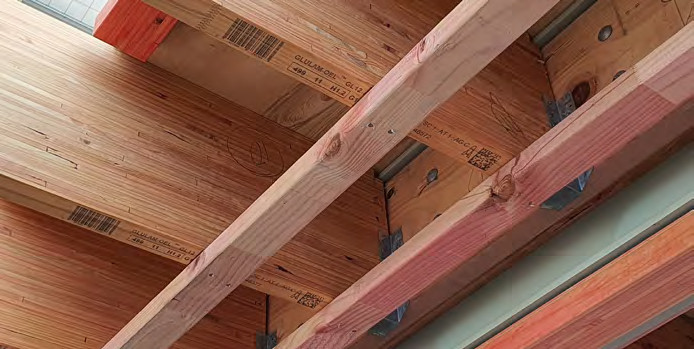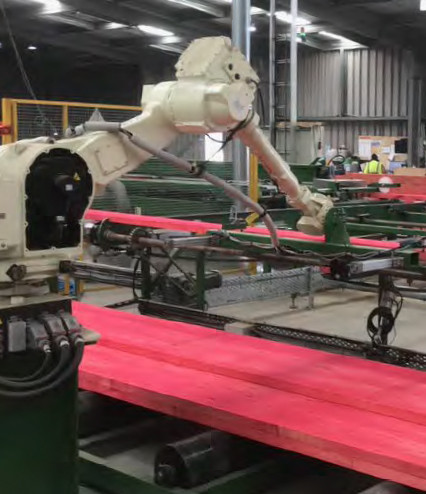Engineering timber for more sustainable buildings
GS1 Standards have a role in Industry 4.0
The future of engineered timber for construction is here – and it requires very smart digital technology, including the use of GS1 concepts and standards.
Innovative start-up Wood Engineering Technology (WET) is making glue-laminated beams that are much lighter, straighter and stronger than conventional milled timber, and are a less costly, more sustainable alternative to steel and concrete for commercial and residential construction. WET’s patented “optimised engineered lumber” (OEL™) system is also a significant advance on older forms of timber lamination.
WET New Zealand Chief Executive Shaun Bosson says OEL™ is a potential game changer for forest processing here and globally because of its improved product quality, its utilisation of lower-grade logs until now rejected for construction, and its commercial and environmental advantages. “We need to make far more use of wood in commercial and residential building given its renewability and lower carbon footprint … OEL™ is a huge step in that direction,” Mr Bosson says.
WET has been producing OEL™ beams at a demonstration plant in Gisborne since April last year, with its system being fine-tuned before output is scaled up and more plants built in other forestry regions. “We want to identify all the issues at an early stage so our system and the quality of production can be optimised at least cost in time and money,” Mr Bosson says.
This approach reflects the innovativeness of both WET’s product and its production technology. Logs of all shapes and sizes are broken down and re-assembled with precision to achieve weight, uniformity and strength characteristics that are unrivalled in other wood products. The Gisborne plant has over 2,500 sensors, scanners and cameras that capture the critical attributes of the wood at each stage, along with huge data processing capabilities which drive automated decision-making and robotic manipulation of logs, timber fragments and finished beams.
In fact, Mr Bosson says, WET is as much a technology company as it is a forestry processor – one of New Zealand’s first working examples of Industry 4.0.
“There are huge data and automation challenges when you’re cutting logs into thousands of small pieces that are going to be re-assembled in an optimal way ... we need to understand the characteristics of all that material throughout the process and determine how it’ll contribute to a finished product with the specifications we’re pursuing. That just isn’t possible without digital technologies,
“We’ve taken the best digital technology available, often found in other industries, improved on it where we can, and imported it into a wood processing environment,” Mr Bosson says. “How we identify objects and materials within our processes is critical … identification is a foundational element in our data harvesting and analysis.”
Industry 4.0 is the embedding of digital technologies and automation into manufacturing processes to achieve big gains in productivity and economic value. The term originated in Germany’s strategy for a more high-tech economy during 2011.
Industry 4.0 brings smart sensors, wireless connectivity, Internet of Things-type data capture and exchange, “cognitive computing” and robotics into the heart of processes for production of physical goods. These trends supersede Industry 3.0 or “the digital revolution” - the economy-wide take up of computing, the Internet and digital communications since the late 1970s.
Wood Engineering Technology has been described by Callaghan Innovation as “an outstanding example of an Industry 4.0 installation in New Zealand”.
Refer: www.callaghaninnovation.govt.nz/forestry-meets-industry-40
Standardised data
And this is where the GS1 system becomes important, especially its concepts of data standardisation and serialisation within a manufacturing process. For example, the company allocates a serialised GTIN (Global Trade Item Number) to each log entering its plant, and being graded on its wood qualities and OEL™ suitability. The GTIN is encoded in a barcode attached to the log for scanning in the early stages of the processing: The various work-in-progress materials that follow are identified by further unique numbers assigned within WET’s operations technology system.
“The use of serialised identification for product and machines is critical to the plant’s operating efficiency,” Mr Bosson says. “As a general rule, for machines to co-operate automatically they need to be uniquely identified, and then capturing and sharing data sets which make sense to each machine … it’s data that enables interoperability between components of the one manufacturing process.
“Our plant is a good demonstration of the interoperability concept and over time, we want to extend this throughout our supply and demand chains. Ultimately we’re looking at an ‘Internet of Things’ application, enabled partly by standardised data and the GS1 system.”
Finished beams can be identified using EAN-13 barcodes attached to individual beams and to packs of them, while production dates and serial numbers are scannable from separate 2-D barcodes. WET has comprehensive master data on all its products, this including 25 attributes which are structured within a GS1 format.
“We’re ready to provide any information in a standardised electronic form, whenever a trading partner requires and for whatever purpose they might have,” Mr Bosson says. Likewise WET is ready to go with GS1-standard eCommerce documents as its supply chain relationships develop with merchants and construction firms.
Sound familiar?
The company’s commitment to maximising value from the GS1 system is hardly surprising – Shaun Bosson was GS1 New Zealand’s Chief Operating Officer for 10 years prior to joining WET full-time in 2016. He also brings many years of experience in process engineering and supply chain management in Europe.
Full production
Looking ahead, Shaun expects the Gisborne plant to begin continuous, production later this year after further fine-tuning, with a second and bigger plant to be built on land next door. Both facilities have been planned as a joint venture between WET and Tairawhiti Trust, a Gisborne-based regional development body and investor. When fully operational, the plants will have the capacity to produce 40,000 cubic metres of engineered lumber annually, enough to build over 1500 homes.
Longer term, WET could have six or so relatively small but high-performing plants strategically sited around New Zealand. “Wherever there is a density of forest resource, we would like to have a plant close by,” Mr Bosson says. And there’s already been work done with other wood species producing excellent results and other geographies where the technology could provide significant benefits.
Forest harvesting
In addition to its product quality attributes, and to the general sustainability virtues of building in wood, OEL™ has the huge advantage of enabling traditionally lower grade and smaller logs to end up as high performing construction timber. Today a significant amount of New Zealand’s forest harvest goes into wooden packaging, concrete form work, or pulp and paper production: WET’s technology converts much of that into laminated beams for construction with the potential to fundamentally change the economics of plantation forestry here and in other countries like the UK (where spruce has traditionally been inferior for building).
Mr Bosson says that WET’s production draws on such diversity from forest harvesting that it addresses a decades-old problem: How to profitably use the “ugly logs”, thinnings and young trees that make up more than half New Zealand’s annual harvest. OEL™ arises from R&D on the issue which started 15 years ago, including work by forestry research institute Scion. WET recently produced OEL™ beams from trees grown over just 10-14 years and the outcome was very high grade for structural use. “When you think that this country’s structural lumber traditionally comes from pines at around 28 years, you see how this technology can radically change the economics of forestry.”
It could also radically change the carbon footprint of new buildings as (renewable resource) logs now exported for relatively low-value use are, instead, manufactured here into products that substitute for carbon-intensive steel and concrete. That, says Mr Bosson, shows the power of combining digital technologies – using global data standards of course – with traditional industry.



